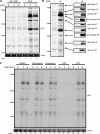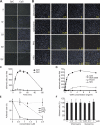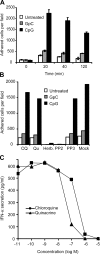CpG-induced tyrosine phosphorylation occurs via a TLR9-independent mechanism and is required for cytokine secretion
- PMID: 16567503
- PMCID: PMC2063763
- DOI: 10.1083/jcb.200508058
CpG-induced tyrosine phosphorylation occurs via a TLR9-independent mechanism and is required for cytokine secretion
Abstract
Toll-like receptors (TLRs) recognize molecular patterns preferentially expressed by pathogens. In endosomes, TLR9 is activated by unmethylated bacterial DNA, resulting in proinflammatory cytokine secretion via the adaptor protein MyD88. We demonstrate that CpG oligonucleotides activate a TLR9-independent pathway initiated by two Src family kinases, Hck and Lyn, which trigger a tyrosine phosphorylation-mediated signaling cascade. This cascade induces actin cytoskeleton reorganization, resulting in cell spreading, adhesion, and motility. CpG-induced actin polymerization originates at the plasma membrane, rather than in endosomes. Chloroquine, an inhibitor of CpG-triggered cytokine secretion, blocked TLR9/MyD88-dependent cytokine secretion as expected but failed to inhibit CpG-induced Src family kinase activation and its dependent cellular responses. Knock down of Src family kinase expression or the use of specific kinase inhibitors blocked MyD88-dependent signaling and cytokine secretion, providing evidence that tyrosine phosphorylation is both CpG induced and an upstream requirement for the engagement of TLR9. The Src family pathway intersects the TLR9-MyD88 pathway by promoting the tyrosine phosphorylation of TLR9 and the recruitment of Syk to this receptor.
Figures









Similar articles
-
CpG DNA enhances macrophage cell spreading by promoting the Src-family kinase-mediated phosphorylation of paxillin.Cell Signal. 2006 Dec;18(12):2252-61. doi: 10.1016/j.cellsig.2006.05.007. Epub 2006 May 23. Cell Signal. 2006. PMID: 16809022
-
Syk is indispensable for CpG-induced activation and differentiation of human B cells.Cell Mol Life Sci. 2015 Jun;72(11):2223-36. doi: 10.1007/s00018-014-1806-x. Epub 2014 Dec 28. Cell Mol Life Sci. 2015. PMID: 25543269 Free PMC article.
-
Impaired integrin-mediated signal transduction, altered cytoskeletal structure and reduced motility in Hck/Fgr deficient macrophages.J Cell Sci. 1999 Nov;112 ( Pt 22):4067-78. doi: 10.1242/jcs.112.22.4067. J Cell Sci. 1999. PMID: 10547366
-
[Multilevel maturation of Toll-like receptor 9].Postepy Hig Med Dosw (Online). 2013 Oct 30;67:1034-46. doi: 10.5604/17322693.1074013. Postepy Hig Med Dosw (Online). 2013. PMID: 24184955 Review. Polish.
-
Endosomal trafficking of Src tyrosine kinase.Trends Cell Biol. 2008 Jul;18(7):322-9. doi: 10.1016/j.tcb.2008.05.004. Trends Cell Biol. 2008. PMID: 18515107 Review.
Cited by
-
Fully phosphorothioate-modified CpG ODN with PolyG motif inhibits the adhesion of B16 melanoma cells in vitro and tumorigenesis in vivo.Nucleic Acid Ther. 2013 Aug;23(4):253-63. doi: 10.1089/nat.2013.0419. Epub 2013 Jul 13. Nucleic Acid Ther. 2013. PMID: 23848522 Free PMC article.
-
Traditional biochemical assays for studying toll-like receptor 9.J Immunoassay Immunochem. 2013;34(1):1-15. doi: 10.1080/15321819.2012.666222. J Immunoassay Immunochem. 2013. PMID: 23323977 Free PMC article. Review.
-
Stimulation of Proliferation and Migration of Mouse Macrophages by Type B CpG-ODNs Is F-Spondin and IL-1Ra Dependent.PLoS One. 2015 Jun 4;10(6):e0128926. doi: 10.1371/journal.pone.0128926. eCollection 2015. PLoS One. 2015. PMID: 26042735 Free PMC article.
-
Phagocytosis of Particulate Antigens - All Roads Lead to Calcineurin/NFAT Signaling Pathway.Front Immunol. 2014 Jan 9;4:513. doi: 10.3389/fimmu.2013.00513. Front Immunol. 2014. PMID: 24409187 Free PMC article. Review. No abstract available.
-
Selective inhibition of spleen tyrosine kinase (SYK) with a novel orally bioavailable small molecule inhibitor, RO9021, impinges on various innate and adaptive immune responses: implications for SYK inhibitors in autoimmune disease therapy.Arthritis Res Ther. 2013 Oct 4;15(5):R146. doi: 10.1186/ar4329. Arthritis Res Ther. 2013. PMID: 24286216 Free PMC article.
References
-
- Ahmad-Nejad, P., H. Hacker, M. Rutz, S. Bauer, R.M. Vabulas, and H. Wagner. 2002. Bacterial CpG-DNA and lipopolysaccharides activate Toll-like receptors at distinct cellular compartments. Eur. J. Immunol. 32:1958–1968. - PubMed
-
- Araiza-Casillas, R., F. Cardenas, Y. Morales, and M.H. Cardiel. 2004. Factors associated with chloroquine-induced retinopathy in rheumatic diseases. Lupus. 13:119–124. - PubMed
-
- Arbibe, L., J.P. Mira, N. Teusch, L. Kline, M. Guha, N. Mackman, P.J. Godowski, R.J. Ulevitch, and U.G. Knaus. 2000. Toll-like receptor 2-mediated NF-kappa B activation requires a Rac1-dependent pathway. Nat. Immunol. 1:533–540. - PubMed
-
- Baek, K.H., S.J. Ha, and Y.C. Sung. 2001. A novel function of phosphorothioate oligodeoxynucleotides as chemoattractants for primary macrophages. J. Immunol. 167:2847–2854. - PubMed
-
- Beaty, C.D., T.L. Franklin, Y. Uehara, and C.B. Wilson. 1994. Lipopolysaccharide-induced cytokine production in human monocytes: role of tyrosine phosphorylation in transmembrane signal transduction. Eur. J. Immunol. 24:1278–1284. - PubMed
MeSH terms
Substances
LinkOut - more resources
Full Text Sources
Other Literature Sources
Miscellaneous

